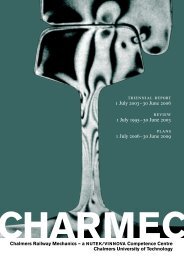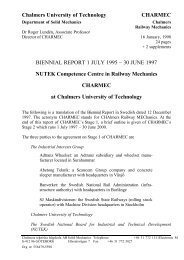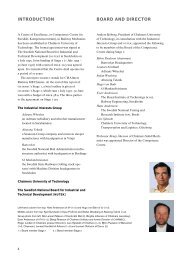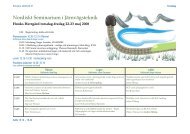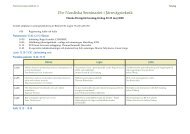You also want an ePaper? Increase the reach of your titles
YUMPU automatically turns print PDFs into web optimized ePapers that Google loves.
Systems for monitoring and operation – System för övervakning och drift (SD) – Systeme für Überwachung und Betrieb – Systèmes pour surveillance et opérationSD4. (cont’d)for different brake histories using both computer simulationsand experimental data. Numerical and experimentalresults obtained in earlier and ongoing work ontread brakes in the projects vb2, sd1 and eu1 have beenutilized. Mr Hans Johansson, Technician of ChalmersApplied Mechanics, contributed to the experimentalwork (see page 52 for photo).It has been found that the heat generated at the contactpatch between wheel and rail due to slip is negligible.Planning of a new full-scale test series has started. In cooperationwith the eu8 project, new three-dimensionalnumerical models of wheels, blocks and rails have beendeveloped and results from simulations using thesemodels are being analysed.There is a delay in project sd4 since Tore Vernerssonhas also been involved in the projects vb3, vb4 and eu8,work which has been time-consuming but which has ledto synergetic effects. The period of the sd4 project asoriginally planned has been extended by one year. Anextensive literature survey has been made and reported.The project sd4 has a reference group with membersfrom sab wabco and TrainTech Engineering.Tore Vernersson: Control of railway block braking – thermomechanicalperformance of wheels: a literature survey, Research<strong>Report</strong> 2002:6, Chalmers Applied Mechanics, Gothenburg 2002,71 ppJens Nielsen, Roger Lundén, Anders Johansson and ToreVernersson: Train-track interaction and mechanisms of irregularwear on wheel and rail surfaces, Vehicle System Dynamics,vol 40, nos 1-3, <strong>2003</strong>, pp 3-54. Presented as an invited KeynoteLecture at the 18th International Symposium Dynamics ofVehicles on Roads and Tracks in Atsugi, Kanagawa (Japan)August <strong>2003</strong> (this reference is also given under project TS5)The brake test rig (inertia dynamometer) in Surahammar at its inaugurationin 1989. From left: Roger Lundén; Josef Rauch (of SuraTraction); Bengt Åkesson; Elisabet Lundqvist and Lennart Nordhall(both of Sura Traction); Mikael Fermér (of Chalmers Solid Mechanics);and Nils Månsson and Sven A Eriksson (both of SJ Machine Division)Parameters controlledBraking air pressure (max 5 bar)Train speed (max 250 km/h)Axle load (max 30 tonnes)Environment (heat, cold, water, snow...)Results recordedBraking momentTemperaturesStrains and stressesWearSimulation of stop braking, drag braking and complete brakingprograms (sequences recorded in-field) is performed in an outdoorenvironment. Disc brakes and block brakes with a maximumwheel diameter of 1500 mm can be handled. An electric motorof maximum power 250 kW drives 2 to 12 fly-wheels, each at630 kg and 267 kgm 2 , with a maximum speed of 1500 rpmDesign for two extreme stop braking cases2m ν 0 s sign s b t b r Q 0 E D n Mtonnes km/h m m s m/s 2 kW kWh m rpm Nm30 140 1000 772 39.7 0.98 571 3.15 0.92 807 676016 250 3500 2837 81.7 0.85 472 5.36 0.88 1500 299050



